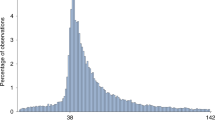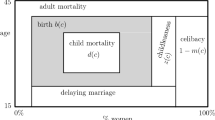Abstract
When wealth is heritable, parents may manipulate family size to optimize the trade-off between more relatively poor offspring and fewer relatively rich ones, and channel less care into offspring that compete with siblings. These hypotheses were tested with quantitative ethnographic data collected among the Karo Batak—patrilineal agriculturalists from North Sumatra, Indonesia, among whom land is bequeathed equally to sons. It was predicted that landholding would moderate the relationship between reproductive rate and parental investment on one hand, and the number of same-sex siblings on the other, among boys but not girls. The predicted interaction effect was observed in interbirth intervals and immunizations, but only a trace of the effect was detected in age-five mortality. The study raises questions about the coevolution of human behavior and social structure.




Similar content being viewed by others
References
Badan Pusat Statistik. (1998). Kabupaten Karo dalam angka, 1998. Berastagi: BPS.
Badan Pusat Statistik and ORC Macro. (2003). Indonesia demographic and health survey, 2002-2003. Calverton: ORC Macro.
Boone, J., & Kessler, K. (1999). More status or more children? Social status, fertility reduction, and long-term fitness. Evolution and Human Behavior, 20, 257–277.
Borgerhoff Mulder, M. (1991). Human behavioural ecology. In J. Krebs & N. Davies (Eds.), Behavioural ecology: An evolutionary approach (3rd ed., pp. 69–98). Boston: Blackwell.
Borgerhoff Mulder, M. (1992). Reproductive decisions. In E. Smith & B. Winterhalder (Eds.), Evolutionary ecology and human behavior (pp. 339–374). Hawthorne: Aldine de Gruyter.
Borgerhoff Mulder, M. (1998). Brothers and sisters: How sibling interactions affect optimal parental allocations. Human Nature, 9, 119–162.
Borgerhoff Mulder, M. (2000). Optimizing offspring: The quantity-quality tradeoff in agropastoralist Kipsigis. Evolution and Human Behavior, 21, 391–410.
Borgerhoff Mulder, M. (2007). Hamilton’s rule and kin competition: The Kipsigis case. Evolution and Human Behavior, 28, 299–312.
Box-Steffensmeier, J., & Jones, B. (2004). Event history modeling: A guide for social scientists. New York: Cambridge University Press.
Clark, A. (1978). Sex ratio and local resource competition in a prosimian primate. Science, 201, 163–165.
Cleves, M., Gould, W., Guttierrez, R., & Marchenko, Y. (2008). An introduction to survival analysis using Stata (2nd ed.). College Station: Stata.
Clutton Brock, T. (1991). The evolution of parental care. Princeton: Princeton University Press.
Collier, G. (1975). The fields of Tzotzil: The ecological basis of tradition in highland Chiapas. Austin: University of Texas Press.
Cronk, L. (1991a). Preferential parental investment in daughters over sons. Human Nature, 2, 387–417.
Cronk, L. (1991b). Intention versus behaviour in parental sex preferences among the Mukogodo of Kenya. Journal of Biosocial Science, 23, 229–240.
Cronk, L. (1991c). Human behavioral ecology. Annual Review of Anthropology, 20, 25–53.
Cronk, L. (1999). That complex whole: Culture and the evolution of human behavior. Boulder: Westview.
Cronk, L. (2007). Boy or girl: Gender preferences from a Darwinian point of view. Ethics, Bioscience and Life, 15, 23–32.
Gadgil, M., & Bossert, W. (1970). Life historical consequences of natural selection. American Naturalist, 104, 1–24.
Gelman, A., & Hill, J. (2007). Data analysis using regression and multilevel/hierarchical models. New York: Cambridge University Press.
Hamilton, W. (1967). Extraordinary sex ratios. Science, 156, 477–488.
Hrdy, S., & Judge, D. (1993). Darwin and the puzzle of primogeniture: An essay on biases in parental investment after death. Human Nature, 4, 1–45.
Ihromi, T. (1994). Inheritance and equal rights for Toba Batak daughters. Law and Society Review, 28, 525–37.
Jaccard, J., & Turrisi, R. (2003). Interaction effects in multiple regression. Quantitative applications in the social sciences, 07-072 (2nd ed.). Thousand Oaks: Sage.
Kipp, R. (1987). Karo Batak rice rituals then and now. In R. Carle (Ed.), Cultures and societies of North Sumatra (pp. 253–273). Berlin: Dietrich Reimer Verlag.
Kipp, R. (1993). Dissociated identities: Ethnicity, religion, and class in an Indonesian society. Ann Arbor: University of Michigan Press.
Kushnick, G. (2006). Parent-offspring conflict among the Karo of North Sumatra. PhD dissertation, Anthropology, University of Washington, Seattle.
Lancaster, J., & Lancaster, C. (1987). The watershed: Change in parental-investment and family-formation strategies in the course of human evolution. In J. Altmann, A. Rossi, & L. Sherrod (Eds.), Parenting across the lifespan: Biosocial dimensions (pp. 187–205). New York: Aldine de Gruyter.
Loeb, E. (1935). Sumatra: Its history and people. Oxford: Oxford University Press.
Low, B. (1990). Occupational status, landownership, and reproductive behavior in 19th-century Sweden: Tuna Parish. American Anthropologist, 92, 457–468.
Low, B. (1991). Reproductive life in nineteenth century Sweden: An evolutionary perspective on demographic phenomena. Ethology and Sociobiology, 12, 411–448.
Low, B., & Clarke, A. (1991). Family patterns in nineteenth-century Sweden: Impact of occupational status and landownership. Journal of Family History, 16, 117–38.
Lycett, J., Dunbar, R., & Voland, E. (2000). Longevity and the costs of reproduction in a historical human population. Proceedings of the Royal Society of London B, 267, 31–35.
Mace, R. (1998). The coevolution of human fertility and wealth inheritance strategies. Philosophical Transactions of the Royal Society of London B, 353, 389–397.
Mace, R. (2000). Evolutionary ecology of human life history. Animal Behaviour, 29, 1–10.
Palloni, A., & Tienda, M. (1986). The effects of breastfeeding and pace of childbearing on mortality at early ages. Demography, 23, 31–52.
Penny, D. H., & Singarimbun, M. (1967). Economic activity among the Karo Batak of Indonesia: A case study of economic change. Bulletin of Indonesia Economic Studies, 6, 31–65.
Pianka, E., & Parker, G. (1975). Age-specific reproductive tactics. American Naturalist, 109, 453–464.
Portier, M. K., & Slaats, H. (1987). Women and the division of parental land in Karo Society. In R. Carle (Ed.), Cultures and societies of North Sumatra (pp. 303–308). Berlin: Dietrich Reimer Verlag.
Quinlan, R., Quinlan, M., & Flinn, M. (2003). Parental investment and age at weaning in a Caribbean village. Evolution and Human Behavior, 24, 1–16.
Rabe-Hesketh, S., & Skrondal, A. (2008). Multilevel and longitudinal modeling using Stata (2nd ed.). College Station: Stata.
Rogers, A. (1994). For love or money: On the evolution of economic motivations in humans. In R. Dunbar (Ed.), Human reproductive decisions: Biological and social perspectives (pp. 76–95). London: St. Martin’s.
Sieff, D. (1990). Explaining biased sex ratios in human populations: A critique of recent studies. Current Anthropology, 31, 25–48.
Silk, J. (1983). Local resource competition and facultative adjustment of sex ratios in relation to competitive abilities. American Naturalist, 121, 56–66.
Singarimbun, M. (1975). Kinship, descent, and alliance among the Karo Batak. Berkeley: University of California Press.
Smith, E. (2000). Three styles in the evolutionary analysis of human behavior. In L. Cronk, W. Irons, & N. Chagnon (Eds.), Human behavior and adaptation: An anthropological perspective (pp. 27–46). Hawthorne: Aldine de Gruyter.
Smith, C., & Fretwell, S. (1974). The optimal balance between size and number of offspring. American Naturalist, 108, 499–506.
Smith, E., & Winterhalder, B. (Eds.). (1992). Evolutionary ecology and human behavior. Hawthorne: Aldine de Gruyter.
Steedly, M. (1993). Hanging without a rope: Narrative experience in colonial and postcolonial Karoland. Princeton: Princeton University Press.
Trivers, R. (1972). Parental investment and sexual selection. In B. Campbell (Ed.), Sexual selection and the descent of man, 1871–1971 (pp. 136–179). Chicago: Aldine.
Trivers, R., & Willard, D. (1973). Natural selection of parental ability to vary the sex ratio of offspring. Science, 179, 90–91.
Van Schaik, C., & Hrdy, S. (1991). Intensity of local resource competition shapes the relationship between maternal rank and sex ratios at birth in cercopithecine primates. American Naturalist, 138, 1555–1562.
Voland, E. (1995). Reproductive decisions viewed from an evolutionarily informed historical demography. In R. Dunbar (Ed.), Human reproductive decisions: Biological and social perspectives (pp. 137–159). London: St. Martin’s.
Voland, E. (1998). Evolutionary ecology of human reproduction. Annual Review Anthropology, 27, 347–374.
Voland, E., & Dunbar, R. (1995). Resource competition and reproduction: The relationship between economic and parental strategies in the Krummhörn Population (1720–1874). Human Nature, 6, 33–49.
Williams, G. (1966). Natural selection, the costs of reproduction, and a refinement of Lack's principle. American Naturalist, 100, 687–690.
Winterhalder, B., & Smith, E. (2000). Analyzing adaptive strategies: Human behavioral ecology at twenty five. Evolutionary Anthropology, 9, 51–72.
Acknowledgments
I thank the people of Doulu and Laubuluh villages for patiently enduring my prodding. I thank Eric Alden Smith (EAS), Monique Borgerhoff Mulder, Emily Brunson, Warren Miller, and three anonymous reviewers for providing useful suggestions. Fieldwork was funded by a National Science Foundation Dissertation Improvement Grant (0003951) awarded to me and EAS, and a “Seed” Grant from the Andrew W. Mellon Foundation. Research in Indonesia was done under the auspices of the Indonesian Academy of Sciences (Lembaga Ilmu Pengetahuan Indonesia, or LIPI) in Jakarta, with sponsorship from the late Amir Syamsu Nadapdap (Department of Anthropology, University of North Sumatra, Medan) and Aswatini Raharto (Center for Population and Manpower Studies, LIPI).
Author information
Authors and Affiliations
Corresponding author
Rights and permissions
About this article
Cite this article
Kushnick, G. Resource Competition and Reproduction in Karo Batak Villages. Hum Nat 21, 62–81 (2010). https://doi.org/10.1007/s12110-010-9082-4
Published:
Issue Date:
DOI: https://doi.org/10.1007/s12110-010-9082-4




